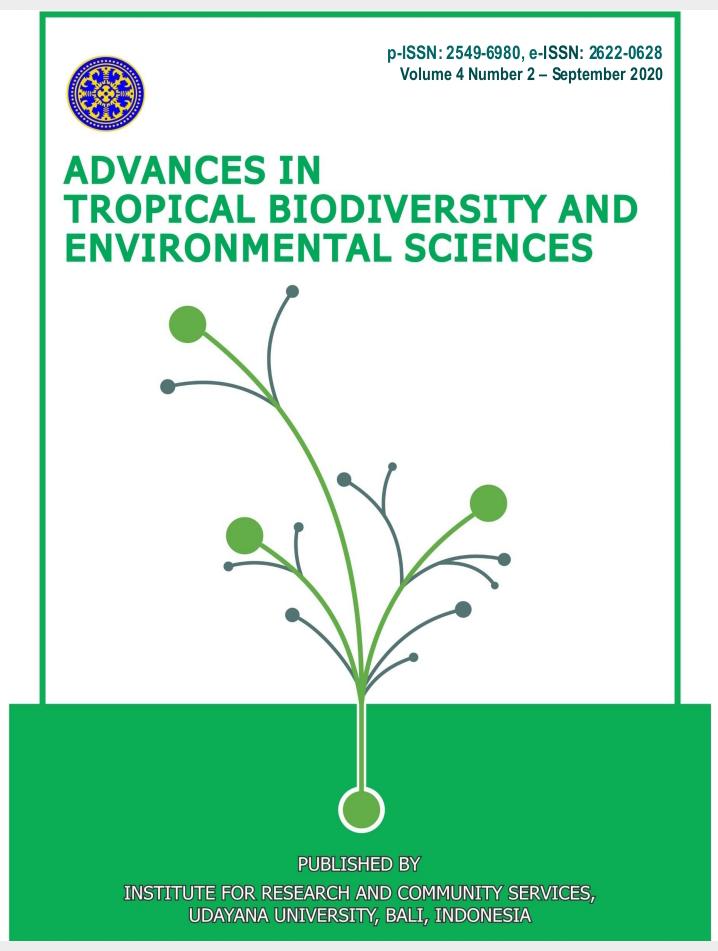Epilithic Diatom Abundance Study in the Batang Kuranji River in Padang City, West Sumatra
Abstract
A study about abundant of epilithic diatom was conducted on 2017 in Kuranji River. The objective of this study was to clarify species and abundant of epilithic diatom in Batang Kuranji River. Samples were collected in 3 stations by purposive sampling and brushing method. The results showed that totally 82 species in 22 genera had been found. The total abundant of epilithic diatom was 15139,26 individual/cm2. The highest abundance of epilithic diatom was found in station I (Batu Busuak) and the lowest in station III (Sawah Liek). Synedra sp and Fragillaria sp were dominant group of diatoms which are found in almost all sites. Some physical and chemical water quality parameters were showed that Batang Kuranji River were polluted slightly by organic and inorganic materials.
Downloads
References
[2] Pasisingi N. 2014. Diatom Epilitik Sebagai Indikator Kualitas Air Di Bagian Hulu Sungai Cileungsi, Bogor. Thesis IPB. Bogor
[3] Siregar SH, A Mulyadi, OJ Hasibuan. 2008. Struktur Komunitas Diatom Epilitik (Bacillariophyceae) Pada Lambung Kapal Di Perairan Dumai Provinsi Riau. Journal of Enviromental Science, Universitas Riau. Pekanbaru.
[4] Kurniawan H. 2014. Penilaian Tingkat Kekritisan Daerah Aliran Sungai (DAS) Batang Kuranji Kota Padang Berdasarkan Biofisik. Thesis Unand. Padang.
[5] Badan Meteorologi Klimatologi dan Geofisika. 2016. Buletin Prakiraan Musim Hujan 2016-2017 Propinsi Sumatera Barat. Jakarta
[6] Belcher H, E Swale. 1978. A beginner’s guide to freshwater algae. Natural Environment Research Council. Combridge.
[7] Bellinger EG, DC Sigee. 2010. Freshwater Algae: Identification and Use as Bioindicators. Wiley, John and Sons, Ltd.
[8] Rice EW, RB Baird, AD Eaton, LS Clesceri. 2012. APHA (American Public Health Association): Standard Method for the Examination of Water and Wastewater 22th ed. Washington DC.
[9] Venter A, A Jordaan, AJH Pieterse. 2003. Oscillatoria simplicissima:A taxonomical study. School of Environmental Sciences and Development: Botany. South Africa. Journal Water SA, 29: 1.
[10] Ravera O. 2001. Monitoring of the aquatic environment by species accumulator of pollutants. Journal of Limnology, 60: 63-78.
[11] Aprisanti R, A Mulyadi, SH Siregar. 2013. Struktur Komunitas Diatom Epilitik Perairan Senapelan dan Sungai Sail, Kota Pekanbaru. Jurnal Ilmu Lingkungan, pp. 244-246.
[12] Afrizal, S. 2008. Kelimpahan dan Penyebaran Diatom Epilitik Pada Sungai Sekitar Kampus Universitas Andalas. Unand. Padang.
[13] Sloane E. 2003. Anatomi dan Fisiologi untuk Pemula, Alih Bahasa J.Veldman, Jakarta, EGC, pp. 290-291.
[14] Wahyuni HI, NP Roxas. 2008. Comparative Study of Pancreatic Enzyme Activity and It’s Histology In Native And Broiler Chicks, Prosiding Seminar Nasional Teknologi Peternakan dan Veteriner 2008, pp. 678-683.
[15] Bhatia D, MK Gupta, A Bharadwaj, M Pathak, G Khatiwas, M Singh. 2008. Anti-diabetic Activity of Centratherum Anthelminticum Kuntze on Alloxan Induced Diabetic Rats. Pharmacologyonline, 3:1-5.
[16] Purnomo MT. 2010. Pengaruh Diet Singkong (Manihot esculenta) terhadap Struktur Histologi Pankreas Tikus Putih (Rattus norvegicus), Surakarta, UNS.













